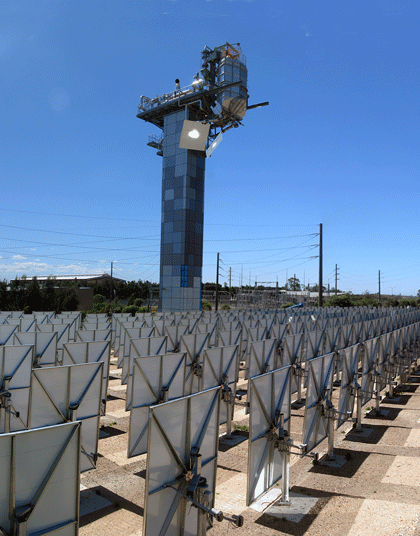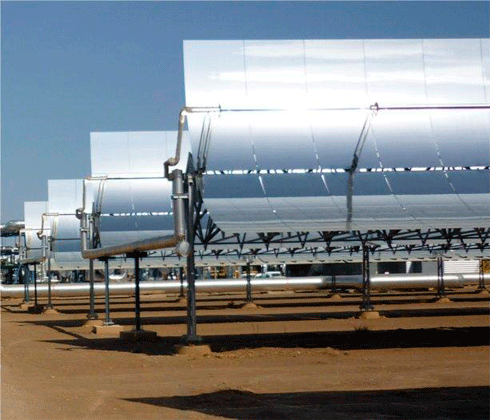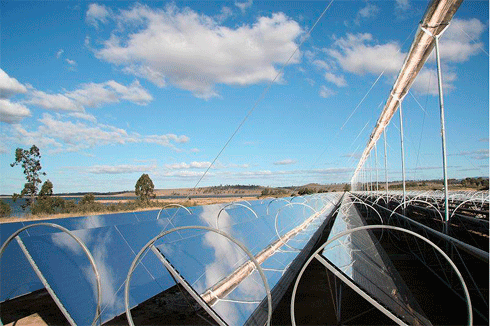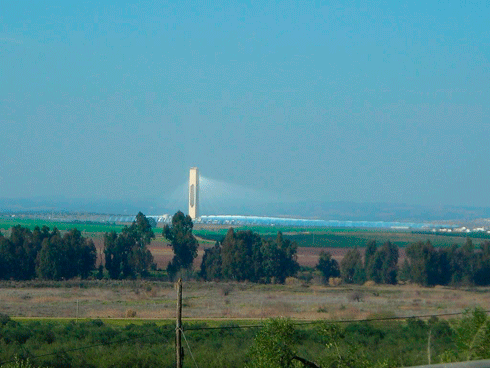
|
Published: 4 May 2011
Returning the goodness from city to soil
Urban communities are refining the age-old technique of composting domestic organic waste to help address the declining fertility of agricultural soils.
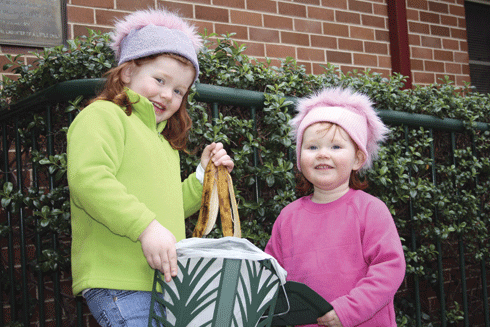
|
|
Two Goulburn girls demonstrate how to use the MaxAir bins and Biobags. Credit: Simone Dilkara, Groundswell Project Manager
|
Each year, every Australian household contributes about a tonne of waste to landfill, approximately 50 per cent of which is organic. The impacts of this disposal include resource depletion, groundwater leaching and methane emission: problems that may be addressed by large-scale composting of food and other organic waste. Returning the compost to farmland may also bring the added benefit of revitalising depleted agricultural soils in local regions.
‘Australia-wide, soil organic matter is being reduced. Up to 60 minerals are taken out of the soil during plant production, but only a few are returned in the form of nitrogenous and superphosphate fertilisers,’ comments Mr John Lawson, General Manager of Development at Global Renewables Australia. Global Renewables runs an industrial-scale composting plant (known as the UR3R plant) at Sydney’s Eastern Creek. The plant turns 25 per cent of waste from four heavily populated council areas into compost for agricultural use and land rehabilitation.
Mr Lawson says that over the past ten years, councils have become increasingly interested in composting to reduce waste going to landfill and sustainably manage nutrients in the waste stream.
‘We have seen a number of really significant projects come to fruition in that time, which has created a [new] level of expertise and infrastructure for delivery,’ he says. ‘Until recently, large-scale composting focused on turning green waste into landscaping materials and soil conditioners such as mulches. These have not been returned to agriculture, because the cost of spreading the material across an area can be lower than its inherent nutrient value, and because of concerns that the nitrogen drawdown value can also set crops back.
‘However, food waste compost can do the same job as manures, and will help return minerals to the soil, especially phosphorus, which is projected to run out within as little as 150 years at present rates of consumption. Phosphorus is a limited resource that we are mining to feed ourselves, so it’s imperative that the nutrients from organic wastes, including food and biosolids, are returned to the soil,’ says Mr Lawson.
Dr John White, Executive Director of Ignite Energy Resources, argues that the decision to compost at a greater rate should be driven as much by economics as by environmental benefits.
‘Installing equipment such as Eastern Creek’s UR3R plant is more expensive than cheap landfill, so a combination of regulation that bans dumping of organic waste into landfill and economic incentives [to recycle organics] should be effective encouragement,’ says Dr White.
Early adopters
Four rural NSW councils are not content to wait for the roll out of policy and legislation designed to promote composting of household waste. In partnership with Zero Waste Australia and the NSW Department of Environment Climate Change and Water (DECCW), they have taken the initiative and started their own programs, under the banner of City to Soil.
The City to Soil collection method began with a trial in the NSW town of Queanbeyan in 2003–04.
‘The trial involved only garden waste and looked at the economics of getting organics out of the waste stream and back into agriculture,’ says Mr Gerry Gillespie who manages DECCW’s sustainability programs in the region. ‘We found that the green waste could be composted and driven up to 200 kilometres to a farm for $50 per tonne, which also included a small profit. The landfill disposal fee for the same volume of waste was $75 per tonne.’
While this trial was relatively small scale, it attracted the attention of several other councils in the area: Lachlan, Goulburn and Palerang.
‘They were interested in conducting a three-year trial that included food waste as well as garden organics in the composting process,’ says Mr Gillespie.
In this project, known as Groundswell, people are given a small bin to put on their kitchen counter. All their kitchen scraps, including meat, fish and vegetables, are placed into a biodegradable cornstarch bag in the bin. Once it is full, the bag is placed into the green waste bin and collected by the regular kerbside pickup. Because the bags are breathable, anaerobic decomposition is limited and there is no smell.
The councils process the waste into compost in different ways. In Goulburn, the process piggybacks off the existing green waste service and equipment. The Lachlan Shire Council, which has its offices in the town of Condobolin, has partnered with the Wiradjuri Condobolin Corporation (WCC) – a local indigenous-run business for waste collection, processing and sale of compost. The WCC has also established an affiliation with the local TAFE for training and skills development of the project’s workers.
The Palerang Council project will begin later this year, and will involve the council transporting organic waste to a purpose-built facility on private property outside Bungendore, where it will be processed. The compost will then be applied to surrounding agricultural land.
‘As evidenced by the low levels of contamination [ie low levels of non-organic waste] in the collected waste, the project has had tremendous support from the communities involved,’ says Mr Gillespie. ‘When the bags arrive at the composting facility, we pick out two that have a code identifying their origin. If the bags have no contaminants, the households win a laundry basket containing $100 worth of fruit and vegetables. This not only rewards the householders’ efforts, but also reinforces the message that it is all about food.’
While much appreciated, hampers are not the primary incentive among residents, according to recent community surveys by Professor Barbara Pamphilon, who is Director of the Australian Institute for Sustainable Communities at the University of Canberra.
‘In Goulburn, where the project began in the midst of the drought and water shortages, residents reported they were motivated by a desire to help local farmers, while residents in Condobolin did not see their garden clippings and kitchen scraps as “waste” but as something that should be used in a productive way,’ says Prof Pamphilon.
‘We are trying to get councils to look at the City to Soil process as best practice, and there has been considerable interest from overseas,’ says Mr Gillespie. ‘We have had engineers from around the world flying in to lift the lids of bins and compost piles for a sniff to prove it to themselves.
‘Newtown in Wales ran a local trial in 2009 because they were interested in the fact that this simple composting process reaches temperatures in excess of 70°C, a critical temperature for the control of many pathogens. This means it complies with veterinary standards aimed at, for example, combating mad cow disease. The councils of Auckland and Ashburton in New Zealand have also expressed interest; locally, the councils of Armidale and Harden will start City to Soil collections in the coming months.’
Testing has shown that all products produced by the composting process – such as bagged garden compost and compost for on-farm application – fall well within relevant standards, including the national compost standard, AS 4454, and the NSW Food Waste Exemption and NSW Biosolids standards. All products achieved a Grade A (unrestricted use) rating for each standard.
Agronomist Mr Chris Houghton recently conducted trials on the compost’s impact on agricultural land. He tested it at the relatively low application rates of 5, 10 and 20 cubic metres to the hectare.
‘We found that overall key soil nutrient levels (nitrogen, phosphorus and potassium) increased at high compost application rates,’ he says. ‘Yield also increased and the quality of crops grown on the treated paddocks improved. We expect that with continued applications over time, improvements will continue, especially in soil structure and water-holding capacity.’
Mr Houghton explains that while the tests show that compost is well suited to agricultural use as a soil conditioner and source of nutrients, it will also be valuable for land rehabilitation projects, such as stabilising road cuttings and establishing new vegetation, and for encouraging pasture growth on former mine sites. This finding is in line with other studies showing that using composted organic waste on mining rehabilitation sites is superior to using fertiliser, topsoil or chicken manure applied at the same rate.1
‘Goulburn’s composting project has produced about 1000 cubic metres per year in the past couple of years, which is a relatively small amount, and could be used on as little as three medium-sized district farms,’ says Mr Houghton. ‘Even though the quantity produced should increase over time as interest grows and more organic waste is diverted to compost, there probably won’t be enough to go around.’
‘People are slowly coming to the realisation that we can’t have any form of human economy without soil,’ adds Mr Gillespie. ‘Composting organics empowers people to look after their own food supply, while offering a cost-effective way to reconfigure waste management.’
More information
City to Soil videos, parts 1 and 2: www.youtube.com/user/CitytoSoil
City to Soil blog: www.groundswellproject.blogspot.com
Peak fertiliser: www.ecosmagazine.com/?paper=EC156p9
Impact of City to Soil compost on agricultural land, Groundswell mid-project agronomy report: tinyurl.com/groundswell-rep


